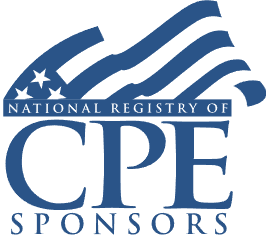Restricted Assets: Managing Donor Restrictions, Financial Reporting, and Liquidity Disclosures
TBD

Course Details
- smart_display Format
On-Demand
- signal_cellular_alt Difficulty Level
Intermediate
- work Practice Area
Accounting
- event Date
Tuesday, November 5, 2019
- schedule Time
1:00 PM E.T.
- timer Program Length
110 minutes
-
BARBRI is a NASBA CPE sponsor and this 110-minute webinar is accredited for 2.0 CPE credits.
-
BARBRI is an IRS-approved continuing education provider offering certified courses for Enrolled Agents (EA) and Tax Return Preparers (RTRP).
-
Live Online
On Demand
This course will provide guidance to not-for-profit organizations (NFPs) and advisers to NFPs that have assets with donor and grant imposed restrictions and board designations. The panel will discuss financial statement reporting under ASU 2016-14, liquidity disclosures, and considerations regarding gift acceptance.
Description
Contributions are sometimes made as a result of a specific fundraising campaign and given for a specific restricted purpose. Contributions may also have conditions stipulated by the donor. Some non-cash contributions may be inherently riskier. Turning down a contribution goes against the grain for most NFPs, but the alternative could be a multitude of insignificant restricted gifts on the books that are difficult to track or spend. Once received, these restricted funds may be at risk to be "borrowed" before spent on the donor restricted purpose by NFPs to meet current operating costs.
Contributions with multiple restrictions increase the complexity for tax advisers. For example, building fund contributions with both time and purpose restrictions could be received and spent but remain restricted assets until construction of the facility is complete. FASB's ASU 2016-14 reduced the number of net asset classes from three to two in the financial statement presentation: net assets with donor restrictions and net assets without donor restrictions.
Financial statement reporting changed to comply with ASU 2016-14 and there are also new liquidity disclosures. The format of the statement of activities and statement of financial position has evolved to incorporate these updates. The new liquidity disclosures include qualitative and quantitative details about the internal limits placed by the board and external limits set by donors, grantors, and other outsiders.
Most notable of all restricted assets are endowment funds. Its disclosures now include reporting accumulated losses as amounts "underwater." The purpose of these ASU changes is to promote transparency, but they also create additional challenges for NFPs and practitioners working with NFPs.
Listen as our panel of experts explains best practices for soliciting and freeing-up donations with strings attached and restricted asset reporting under ASU 2016-14, including financial statement presentation and endowment fund disclosures.
Outline
- Types of asset restrictions
- Best practices for handling designated contributions
- Best practices when soliciting designated fundraising contributions
- How to properly free-up long-held designated contributions
- Financial reporting
- Liquidity disclosures
Benefits
The panel will review these and other essential issues:
- How are restricted assets reported in the financial statements under ASU 2016-14?
- When should a nonprofit consider declining a donor's contribution with strings attached?
- How should NFPs structure fundraising campaigns to ensure that the fundraising campaign's funds are all spendable and to meet the needs of the organization?
- What is an underwater endowment fund?
- How is a NFP's liquidity reported under the new disclosure?
NASBA Details
Learning Objectives
After completing this course, you will be able to:
- Identify restricted assets
- Ascertain when to consider declining a contribution with strings attached
- Determine how to report restrictions on the statement of financial position
- Decide whether an endowment is underwater
- Field of Study: Accounting
- Level of Knowledge: Intermediate
- Advance Preparation: None
- Teaching Method: Seminar/Lecture
- Delivery Method: Group-Internet (via computer)
- Attendance Monitoring Method: Attendance is monitored electronically via a participant's PIN and through a series of attendance verification prompts displayed throughout the program
- Prerequisite: Three years+ business or public firm experience at mid-level within the organization, preparing complex tax forms and schedules; supervisory authority over other preparers/accountants. Specific knowledge and understanding of cost allocation principles; familiarity with government standards for nonprofit organizations receiving federal grant monies

Strafford Publications, Inc. is registered with the National Association of State Boards of Accountancy (NASBA) as a sponsor of continuing professional education on the National Registry of CPE Sponsors. State boards of Accountancy have final authority on the acceptance of individual courses for CPE Credits. Complaints regarding registered sponsons may be submitted to NASBA through its website: www.nasbaregistry.org.

Strafford is an IRS-approved continuing education provider offering certified courses for Enrolled Agents (EA) and Tax Return Preparers (RTRP).
Unlimited access to premium CLE courses:
- Annual access
- Available live and on-demand
- Best for attorneys and legal professionals
Unlimited access to premium CPE courses.:
- Annual access
- Available live and on-demand
- Best for CPAs and tax professionals
Unlimited access to premium CLE, CPE, Professional Skills and Practice-Ready courses.:
- Annual access
- Available live and on-demand
- Best for legal, accounting, and tax professionals
Unlimited access to Professional Skills and Practice-Ready courses:
- Annual access
- Available on-demand
- Best for new attorneys
Related Courses
Recommended Resources
Gain a Competitive Edge Through Efficient CPE Strategies
- Learning & Development
- Business & Professional Skills
- Career Advancement
